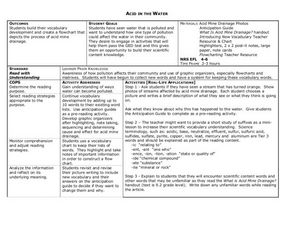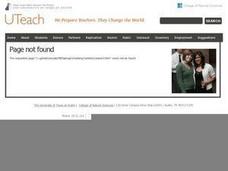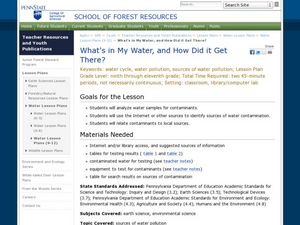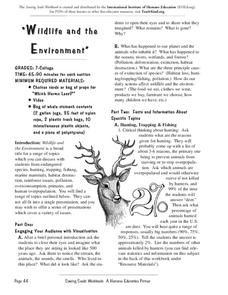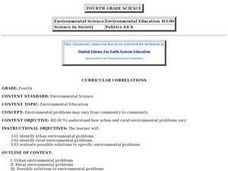Curated OER
Acid in the Water
Ninth graders learn about the effect pollution has on water and how this affects their community. In this environmental awareness lesson, 9th graders expand their vocabulary and create a flowchart that demonstrates the...
Curated OER
To Diaper or Not to
Students examine the environmental impact of disposable diapers. In this environmental impact lesson students discover the materials used in disposable diapers.
Curated OER
Environmental Education/Water Pollution
Fifth graders play a game in which they list as many environmental issues or terms in alphabetical order. They brainstorm ways they can save the environment and create a mural that displayed research found from the internet and Encarta.
Curated OER
Packaging: What a Waste!
Students examine the environmental and economic impacts of excess packaging. They investigate the price and relative amount of processing and packaging of different food products in a local grocery store, analyze graphs, and complete a...
Curated OER
Nanaotechnology: Small Science, BIG DEAL!
Students read an article that introduces them to the science and applications of nanotechnology. They discuss the the everyday examples of how nanotechnology is and can be used. In small groups, they observe and make inferences about...
Curated OER
Is Dilution the Solution to Pollution?
Pupils explore the different types of pollution. they conduct experiments using dye mixed with tap water to measure the levels of dilution. They discuss at what point the dye (pollution) would be diluted enough to be safe to drink.
Curated OER
Seahawk Educational & Environmental Discovery Program
Students identify and describe local poisonous plant/animals. They compare characteristics of three local ecosystems and describe common plants from different ecosystems; comparing shapes, colors, textures, and measuring sizes.
Curated OER
What's in My Water, and How Did it Get There?
Students analyze water samples to see the contaminants and then use the Internet to find the sources of the contamination. In this investigative water lesson students analyze water and work together to solve the mystery of...
Curated OER
What I Can Do on Summer Vacation
Students explore environmentally friendly activities for summer vacation on the Gulf and create a travel guide for these activities.
Curated OER
Is Our Water Clean?
Students identify qualities of clean water which will develop an awareness of people in the community who keep our water clean. This lesson has a literature tie-in with the "Magic School Bus" series.
Curated OER
Environmental Education
In this environment worksheet, middle schoolers read about the numerous activities and then take part in participating in one as a teacher or student led project.
Curated OER
Ecosystems: What Are They and How Do They Work?
Students explore the characteristics of major ecosystems, the interactions of the organisms within the systems, and the effects of humans on the system. Both living and non-living components are examined in this five lesson unit.
Curated OER
Are You a Water Waster?
Learners determine what it means to be water wasters. In this water conservation lesson plan, students follow the provided procedures to identify how much water is used in their household when people brush their teeth.
Curated OER
What are the Chemical and Microbiological Effects of Run-off from a Catfish Pond on the Surrounding Soil and Water?
Students study data from a USDA catfish pond. They look for microbial populations and chemical concentrations in the runoff to determine the effectiveness of filter strips. They use their knowledge of biogeochemical cycles to explain the...
Curated OER
Environmental Education -- Communities
Fourth graders identify urban and rural environmental problems. They work together to develop possible solutions. They ask questions to end the lesson.
Curated OER
Standards And Science
Students study how standards are established in Science. They also look at the value of different perspectives with questions about ecological standards. The class creates its own standards for ecology with the help of a survey to obtain...
Curated OER
Outcomes Science 4: Earth & Beyond
In this earth and beyond science worksheet, students read through 11 pages of information on weather, global warming, climate change and other related topics. There are many website links on the pages that provide additional information...
Curated OER
Cumulative Effects Assessment - What if?
Tenth graders discuss natural and human influences that may affect the ecological integrity of national parks. They study the concepts environmental assessments. In groups, they research a park's situation and present their findings at a...
Curated OER
What Are the Ethical Considerations
Students investigate the socioeconomic and environmental issues associated with radon. They examine the laws that exist in New Jersey that pertain to real estate. They work in groups to design new legislation that addresses associated...
Curated OER
What Do Genes Look Like?
Seventh graders describe the basic structure of the DNA molecule. They identify what an inherited trait is and how it can be determined by one or more genes. Finally, 7th graders identify that plant and animal cells contain several...
Curated OER
What Are Our Risks From Radon?
High schoolers discover the risks from radon. They examine a graph of what a low dose of radon will do to a human body and then discuss. They answer questions to complete the instructional activity.
Channel Islands Film
Santa Cruz Island - Writing for Information
After re-viewing a documentary segment on the restoration of Santa Cruz Island,, individuals craft an essay in which they compare the views of the various stake holders featured in the video and identify the point of view they find...
Curated OER
The Environment
Students, while engaged in a group discussion, collaborate a mini-project on environmental issues at home and/or in the classroom as well as incorporating environmentally related words and expressions within their daily diary writing...
Curated OER
Progression's Price
Students reflect upon their regional and national environments, analyze causes of environmental problems as well as their implications, and examine effects of population growth as they participate in "The Popcorn Game."


